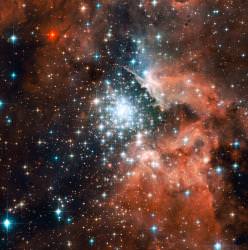It’s time for another amazing image from Hubble. You’re looking at nebula NGC 3603, one of the most spectacular star forming regions in the Milky Way. It’s located about 20,000 light-years away from the Earth, in the Carina spiral arm. Apart from offering up pretty pictures, this region is important for science too. Birth and death, gas and dust, NGC 3603 has it all.
This Hubble image shows many different things happening, all at the same time. Most of the stars in the image were all born in the nebula, and differ in size, mass, temperature and colour. There are some absolute monsters in there, dozens of times the mass of our own Sun. These huge stars live fast and die young, burning through their hydrogen fuel quickly, and blowing out fearsome ultraviolet radiation. The combined radiation of all the stars has carved out an enormous cavity of gas and dust in the centre of the nebula – the clear region in the middle.
According to astronomers, the most massive stars are concentrated into the centre of the cluster. In fact, three of them seem to have more mass than is theoretically possible. Instead of single stars; however, they might be binary pairs, so close that even Hubble can’t distinguish them. The largest star was measured with a mass of 115 times the mass of our Sun. So, either the observations or the theories are wrong; stay tuned to see how this one plays out.
Around the swirling nebula are some darker regions called Bok globules. These are dark clouds of gas and dust with the mass of about 10-50 times our Sun. They’re under the process of collapsing, and will eventually form stars, but for now they’re some of the coldest objects in the Universe. You need cold gas before you can get hot stars.
The entire nebula seems contain about 400,000 times the mass of the Sun. That’s enough material for plenty of stars.
Original Source: ESA Hubble News Release

